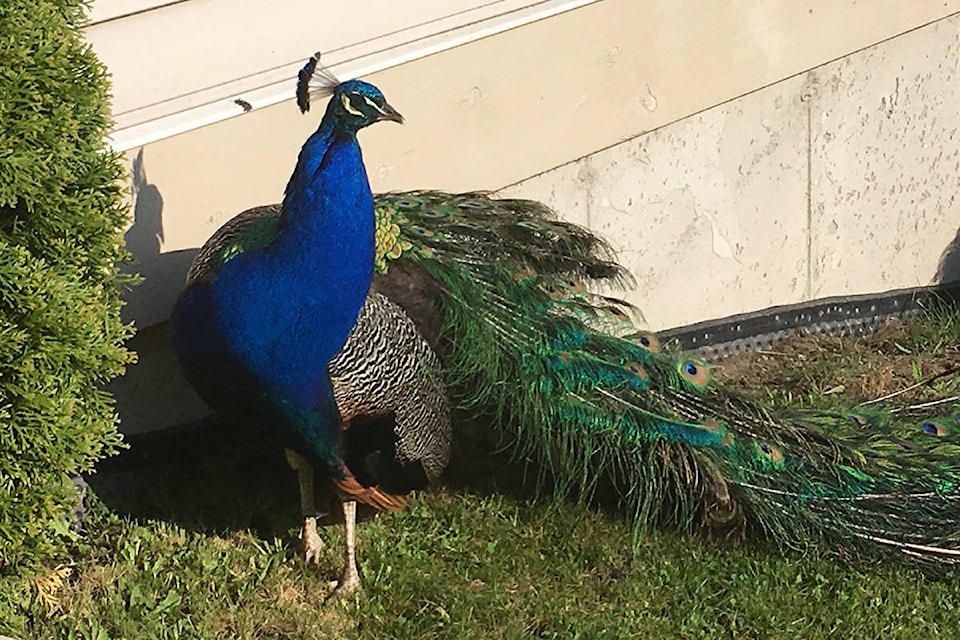Surrey City Council has approved a plan to relocate an estimated 100 peacocks that have been ruffling feathers in Sullivan Heights.
The plan involves capturing and relocating all the birds to Surrey Animal Resource Centre.
“A certified contractor will be retained and a project timeline/budget will be finalized,” notes a report signed by Jas Rehal, Public Safety Operations Manager. “Once peafowl are captured, they will be transported to the Surrey Animal Resource Centre and be subject to the standardized intake procedure, including a medical evaluation.”
From there, the city will work with people from around the province who have reached out expressing interest in taking the birds, to have the peacocks relocated.
Under the proposed plan, eggs would be removed from public property, and from private property by owner request.
“Humane traps” would also be provided to owners, upon request, and education on monitoring those traps would be provided.
“Once peafowl are captured, bylaw officers will remove them immediately,” the staff report notes, adding all traps would be safe for residents, children and other animals.
A Certified Biologist would be hired to oversee the action plan, as well.
Due to the complex nature of this plan, “a long-term commitment by the city to resolving this issue may be required,” Rehal said in his report, noting the flighted birds are difficult to trap, given they roost in elevated locations.
The city’s plan also means residents who feed or house the birds will face stiff fines, and there will be “increased enforcement” with “zero tolerance” for those found to be doing so.
Anyone found in violation will face a $250 fine, under the city’s nuisance bylaw.
And, anyone found to be keeping a peafowl would face a fine of $450 per bird, and the peafowl would be seized.
“If any peafowl are left behind, the issue will continue to exist,” Rehal notes in his report to council.
“While the community continues to be divided on the issue of peafowl, staff recognize the negative impacts to safety and property caused by the nuisance peafowl,” Rehal’s report notes. “Staff appreciate some residents want them to remain as an aesthetic value, but a residential area is not an appropriate place for peafowl. Tensions continue to rise in the area, and staff receive a high amount of daily calls, emails and complaints.
“The primary issues raised by residents have been related to noise, excrement, damage to property and aggressive behaviour towards domestic pets and children,” Rehal added.
Staff plan to hold a neighbourhood meeting on Thursday, July 12th at the Surrey Operations Centre (6651 148 St.) to inform the community of the forthcoming plan.
Complaints about the birds go back to 2010 after a previous homeowner left them behind in 2006.
As the residential community grew, so too did the bird population.
Over the years some in the community have developed a fondness for the birds, while others find them to be a nuisance, Rehal’s report notes.
While the city sent a local expert to conduct a site evaluation several years ago, Rehal’s report notes some locals “intervened and objected” to the trapping of the birds.
Then on April 30, the peacocks made headlines when a frustrated homeowner was fined $1,000 after cutting down a tree known to be a home to the peacocks, saying the city’s inaction left him no choice.
They were in the news once more when video footage surfaced of peacocks damaging vehicles.
SEE ALSO: Surrey man says he illegally cut peacock tree out of desperation
READ ALSO: SIMPSON: Peacock problems dragged on far too long in Surrey
In looking to other communities and experts, Surrey staff say the “complex and divisive issue has not been quickly or easily resolved in other municipalities.”
Longboat Key, Florida began a peafowl removal program in January 2016 and Surrey staff say their efforts were “incomplete.”
“The population (while much smaller) is growing again,” Rehal’s report notes. “They have used both contract trappers and staff to manage their efforts.”
Ranchos Palos Verdes, California began a peafowl removal process in August 2015 and currently have “small pockets of remaining peafowl in several neighbourhoods that are removed on a complaint basis by the Los Angeles Zoo,” Surrey staff note, adding, “they have intensively resourced the issue through their Code Enforcement Department with additional staff and by working collaboratively with the Los Angeles Zoo.”
Australia, meantime, is developing a national strategy to address feral peafowl populations which may be adopted this summer, Rehal notes.
“(Australia’s) strategy includes a variety of potential resolutions that can be applied in individual locations – for example: stabilizing the population by removing all reproductive peafowl, culling the entire population or leaving the peafowl as is.”
